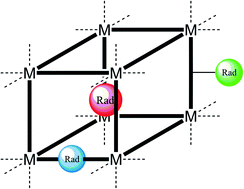Radicals in metal–organic frameworks
Abstract
The burgeoning field of metal–organic frameworks (MOFs) has been marked by numerous key advances over the past two decades. An emerging theme is the incorporation of radical species which may be ligated as an integral structural component of, or simply appended to, the material, or else merely a guest within it. Radical incorporation has been shown to endow MOFs with a plethora of unique and fascinating magnetic, electronic and optical properties, paving the way towards their application as spin probes, and in magnetic/electronic devices, chemical sensing and molecular recognition. In view of the rapid growth of the literature in the area, this review highlights progress over the past three years (since 2011), and seeks to uncover promising ideas that will underscore future advancements at both the fundamental and applied levels.

- This article is part of the themed collection: Supramolecular chemistry: self-assembly and molecular recognition

 Please wait while we load your content...
Please wait while we load your content...